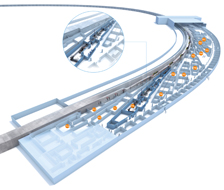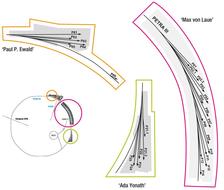Layout of the installations inside the PETRA III experimental hall “Max von Laue” including the ring tunnel, the optics and experiment hutches as well as control cabins.
PETRA III experimental hall 'Max v. Laue'
P01 – High-Resolution Dynamics
P01 specialises in Nuclear Resonant Scattering (NRS) and Inelastic X-ray scattering (IXS and RIXS) experiments at photon energies between 2.5 keV and 80 keV. The beamline offers high energy resolution in the range from 1 meV to about 1 eV and high spatial resolution in the (sub-)micron regime.
P02.1 – Powder Diffraction and Total Scattering
P02.1 provides high-resolution powder X-ray diffraction in the hard X-ray regime, with a fixed energy of 60 keV, making it particularly useful for high Z materials. The high-energy also allows total scattering data to be collected (typical QMax = 20 Å-1) for Pair Distribution Function Analysis. A range of sample environments for non-ambient (e.g. variable temperature measurements) are available.
P02.2 – Extreme Conditions
P02.2 is specialised in micro diffraction experiments on single crystals, powders and non-crystalline materials performed at extreme conditions of high pressure and simultaneous high- or low-temperature (e.g. in the Diamond Anvil Cells) with an emphasis on time-resolved measurements. The beamline operates at 25.6, 42.7 or 60 keV.
P03 – Micro- and Nanofocus X-ray Scattering
P03 offers small- and wide-angle X-ray scattering (SAXS/WAXS). Exploiting the low emittance of the PETRA III source, P03 provides micro- and nanofocussed X-ray beams with energies in the range 9-23 keV.
P04 – Variable Polarization XUV Beamline
P04 allows a wide range of experiments with soft X-rays in the fields of gas phase physics, magnetic spectroscopy, high-resolution photoelectron spectroscopy, surface chemistry, soft X-ray diffraction and holography. The beamline provides exceptionally high photon fluxes (1012 ph. s-1) in the soft X-ray regime, over an energy range from 250-3000 eV.
P05 – Imaging Beamline
P05 is dedicated to micro- and nanotomography at energies between 5 keV and 50 keV. Sample sizes which may be studies at the beamline range from 100µm up to 10 mm. Phase contrast imaging methods including inline phase contrast and grating based phase contrast are available as well as regular absorption contrast imaging.
P06 – Hard X-ray Micro/Nano-Probe
P06 offers visualisation with micro- or nanoscopic spatial resolution using a range of X-ray techniques such as X-ray fluorescence (XRF), X-ray absorption spectroscopy (XAS) and X-ray diffraction (XRD), over the energy range 5-21 keV. Coherent diffraction imaging applying ptychographic scanning schemes enables X-ray microscopy with increased spatial resolution down to the low nanometer range.
P07 – High-Energy Materials Science (HEMS)
P07 offers high-energy X-ray diffraction (XRD) and imaging techniques with tunable X-ray energies in the range of 30 to 200 keV. Micrometer focussing is also possible with Compound Refractive Lenses (CRLs). Experiments aim to investigate relationships between macroscopic and micro-structural properties of polycrystalline materials, grain-grain-interactions, recrystallisation processes, the development of new & smart materials or processes and in situ catalysis mechanisms.
P08 – High-Resolution Diffraction
P08 is designed for diffraction and scattering studies on condensed matter samples, with high-resolution in both real- and reciprocal-spaces. The beamline performs a mix of diffraction, small angle scattering and reflectometry experiments with energies in the range 5.4 to 29.4 keV and beam sizes from 1.5 x 1.0 mm down to focussed beams of 30 x 2 µm.
P09 – Resonant Scattering and Diffraction / HiPhax
P09 is designed to operate in the hard X-ray regime with energies ranging from 2.7 to 31 keV. The beamline consists of three experimental hutches. The first two experimental hutches, EH1 and EH2, are dedicated to resonant X-ray scattering and general diffraction. The 3rd Hutch is dedicated to high throughput pharmaceutical screening.
P10 – Coherence Applications Beamline
P10 serves three main experimental goals: investigation of sample dynamics in the range from microseconds to seconds by X-ray Photon Correlation Spectroscopy (XPCS); coherent diffractive imaging of micro- and nanostructures (CDI); and time-resolved small angle X-ray spectroscopy (SAXS) studies of complex liquids (Rheo-SAXS). The beamline operates in the medium-hard X-ray regime (5-25keV).
P11 – High-throughput Macromolecular Crystallography beamline
P11 is a tunable beamline dedicated to High-throughput Macromolecular Crystallography (MX) with usual operation energy from 6 to 20 keV, multiple focus sizes (from 200 x 200 to 5 x 10 μm2) and an automated sample changer with a large capacity (23 unipucks). Remote operation and serial crystallography with tapedrive are enabled.
P12 – BioSAXS Beamline (operated by EMBL)
P12 is optimised for low background data collection for biological small angle scattering (BioSAXS) experiments on macromolecular solutions or kinetics experiments with high temporal resolution. Fully automated and remote data acquisition and processing are available using the robotic sample changer and the Beamline Meta Server software.
P13 – Macromolecular X-ray Crystallography (operated by EMBL)
P13 is a macromolecular crystallography beamline for single crystal biomolecule structure determination and fluorescence measurements, operated by EMBL Hamburg. The beamline operates at 4.5 to 17.5 keV with both micro-beam (30x20 µm beamsize) and unfocused beam (with a maximum size of 105 µm) for larger crystals.
P14 – Macromolecular X-ray Crystallography (operated by EMBL)
P14 is a macromolecular crystallography beamline for single crystal biomolecule structure determination and fluorescence measurements, operated by EMBL Hamburg. The beamline operates at 6 to 20 keV with both micro-beam (5x5 µm beamsize) and unfocused beam (with a maximum size of 200 µm) for larger crystals.
PETRA III experimental hall 'Ada Yonath'
P21.1 - High-Energy X-Ray Diffraction for Physics and Chemistry at the Swedish Materials Science Beamline
The Swedish Materials Science beamlines (SMS) are dedicated to materials research using high-energy X-rays. P21.1 is a versatile instrument for diffraction and scattering experiments at fixed photon energies of 54, 88, or 103 keV. Its focus lies on total scattering and diffuse scattering on disordered materials and single crystals. Complex sample environments are readily integrated on the heavy load sample stage. While Swedish proposals are eligible to privileged access, the beamline is also available to non-Swedish users.
P21.2 - The Swedish Materials Science Beamline: Diffraction, scattering & imaging
The inline branch P21.2 of the Swedish materials science beamline (SMS) operates in the energy range of 40 - 150 keV and is in particular designed for the combination of WAXS, SAXS, and Imaging techniques. Broad and narrow bandwidth beams are provided in various point- and line-focusing combinations. Both, bulk and surface samples are characterized during in-situ and in-operando processing. While Swedish proposals are eligible to privileged access, the beamline is also available to non-Swedish users.
P22 – Hard X-ray Photoelectron Spectroscopy (HAXPES)
The beamline is dedicated to HAXPES applications (2.4 to ~15 keV) with variable energy resolution and photon polarization. It provides specialized and worldwide unique instruments. The main HAXPES setup employs an electron analyzer with an optional 2D spin filter detector. A separate HAXPEEM instrument allows for spectro-microscopy applications in the keV regime. In addition, an ambient pressure HAXPES system for in-operando studies at local pressures beyond 1 bar will be available.
P23 – In situ X-ray Diffraction and Imaging
P23 is designed for X-ray reflectivity, resonant X-ray scattering, grazing incidence diffraction, X-ray standing waves. Other techniques such as powder diffraction, SAXS/GISAXS, XANES and coherent X-ray diffraction are also available with some restrictions. It provides a 5+2 circle diffractometer for sample cells up to 150 kg (horizontal scattering) and up to 15 kg on an Eulerian cradle (vertical mode). Data can be collected in the range 5 keV to 35 keV, up to 50 keV with limited focusing.
P24 – Chemical Crystallography
P24 is designed for a range of experiments on single crystalline samples under ambient or non-ambient conditions including classical crystal structure studies, diffuse scattering studies and charge density analysis, as well as studies of phase transitions, disordered and modulated structures.There are two experiment hutches: EH1 equipped with a Kappa diffractometer and EH2 with an Eulerian diffractometer. Data can be collected at 8 keV or in the range 17 to 44 keV.
PETRA III experimental hall 'Paul P. Ewald'
P61 – High-Energy wiggler beamline/LVP
Beamline P61 is the high-energy (30-200 keV) Wiggler beamline dedicated to Engineering Materials Science research (hereon, P61A) and Extreme Conditions research in the Large Volume Press, LVP (DESY, P61B). Both independent stations share the beam 50% and are dedicated to energy-dispersive X-ray diffraction and absorption-contrast imaging (radiography) using high-purity Germanium detectors and high-speed cameras combined with a scintillator and objective (for magnification), respectively. The scientific aims of P61A are stress determination in manufactured parts, micro-beam radiotherapy and in-operando laser welding, and of P61B to explore deep-Earth processes and investigate novel materials at high-temperature-high-pressure conditions in the LVP using X-rays and other in situ techniques.
To apply for LVP experiments without beam, please visit the P61B webpage for more information.
P62 - Small Angle X-ray Scattering Beamline for Materials Research
The beamline P62 is designed for anomalous SAXS/WAXS, SAXS/WAXS computed tensor tomography, In situ and In operando SAXS/WAXS as well as high-throughput SAXS/WAXS applications. The X-ray energy range available is 3.5 keV up to 35.0 keV.
P64 – Advanced X-ray Absorption Spectroscopy Beamline
P64 is dedicated to X-ray absorption spectroscopy experiments requiring high photon fluxes. Among those are quick EXAFS (QEXAFS) on the 20-100ms time-scale, EXAFS of highly-diluted systems, and high-resolution spectroscopy with a dispersive fluorescence spectrometer in von-Hamos geometry. Typical applications include studies of mixed-valence compounds, catalysis or local environment of active metallic center in biological molecules.
P65 – Applied X-ray Absorption Spectroscopy Beamline
P65 is designed for classical EXAFS applications, providing an unfocused undulator beam (0.5x1 mm2) which is ideally suited for in situ investigations of catalysts, batteries etc., but also for all kinds of samples with sizes larger than 1 mm2. Applications include basic physics, material sciences, biology, environmental sciences and geochemistry. Diluted or in-transparent samples can be measured in fluorescence yield XAFS mode.
P66 – Time-resolved Luminescence Spectroscopy Beamline
P66 'SUPERLUMI' is operated in the UV-VUV spectral region with pulsed synchrotron excitation in nanosecond range. The beamline is mostly dedicated to time-resolved luminescence spectroscopy experiments focusing on wide band gap materials. These materials are important for environmental, energetics, transport and medical applications.








